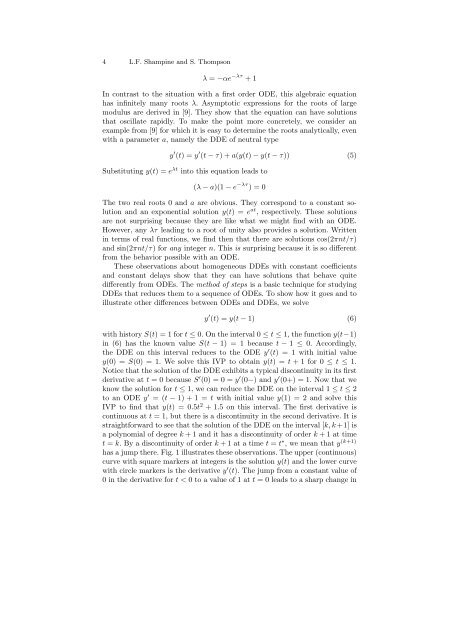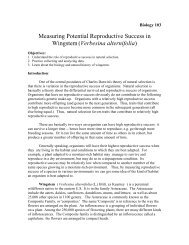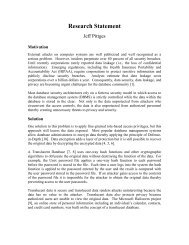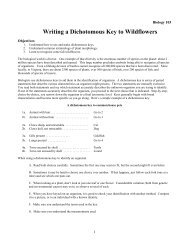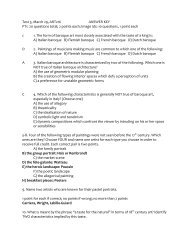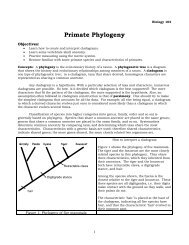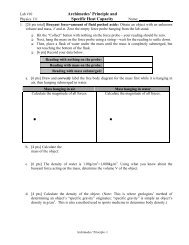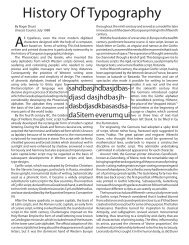Solving Delay Differential Equations - Radford University
Solving Delay Differential Equations - Radford University
Solving Delay Differential Equations - Radford University
Create successful ePaper yourself
Turn your PDF publications into a flip-book with our unique Google optimized e-Paper software.
4 L.F. Shampine and S. Thompson<br />
λ = −αe −λτ + 1<br />
In contrast to the situation with a first order ODE, this algebraic equation<br />
has infinitely many roots λ. Asymptotic expressions for the roots of large<br />
modulus are derived in [9]. They show that the equation can have solutions<br />
that oscillate rapidly. To make the point more concretely, we consider an<br />
example from [9] for which it is easy to determine the roots analytically, even<br />
with a parameter a, namely the DDE of neutral type<br />
y ′ (t) = y ′ (t − τ) + a(y(t) − y(t − τ)) (5)<br />
Substituting y(t) = e λt into this equation leads to<br />
(λ − a)(1 − e −λτ ) = 0<br />
The two real roots 0 and a are obvious. They correspond to a constant solution<br />
and an exponential solution y(t) = e at , respectively. These solutions<br />
are not surprising because they are like what we might find with an ODE.<br />
However, any λτ leading to a root of unity also provides a solution. Written<br />
in terms of real functions, we find then that there are solutions cos(2πnt/τ)<br />
and sin(2πnt/τ) for any integer n. This is surprising because it is so different<br />
from the behavior possible with an ODE.<br />
These observations about homogeneous DDEs with constant coefficients<br />
and constant delays show that they can have solutions that behave quite<br />
differently from ODEs. The method of steps is a basic technique for studying<br />
DDEs that reduces them to a sequence of ODEs. To show how it goes and to<br />
illustrate other differences between ODEs and DDEs, we solve<br />
y ′ (t) = y(t − 1) (6)<br />
with history S(t) = 1 for t ≤ 0. On the interval 0 ≤ t ≤ 1, the function y(t−1)<br />
in (6) has the known value S(t − 1) = 1 because t − 1 ≤ 0. Accordingly,<br />
the DDE on this interval reduces to the ODE y ′ (t) = 1 with initial value<br />
y(0) = S(0) = 1. We solve this IVP to obtain y(t) = t + 1 for 0 ≤ t ≤ 1.<br />
Notice that the solution of the DDE exhibits a typical discontinuity in its first<br />
derivative at t = 0 because S ′ (0) = 0 = y ′ (0−) and y ′ (0+) = 1. Now that we<br />
know the solution for t ≤ 1, we can reduce the DDE on the interval 1 ≤ t ≤ 2<br />
to an ODE y ′ = (t − 1) + 1 = t with initial value y(1) = 2 and solve this<br />
IVP to find that y(t) = 0.5t 2 + 1.5 on this interval. The first derivative is<br />
continuous at t = 1, but there is a discontinuity in the second derivative. It is<br />
straightforward to see that the solution of the DDE on the interval [k, k +1] is<br />
a polynomial of degree k + 1 and it has a discontinuity of order k + 1 at time<br />
t = k. By a discontinuity of order k + 1 at a time t = t ∗ , we mean that y (k+1)<br />
has a jump there. Fig. 1 illustrates these observations. The upper (continuous)<br />
curve with square markers at integers is the solution y(t) and the lower curve<br />
with circle markers is the derivative y ′ (t). The jump from a constant value of<br />
0 in the derivative for t < 0 to a value of 1 at t = 0 leads to a sharp change in


